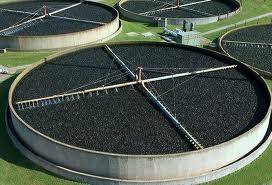A trickling filter sometimes referred to as a percolating filter or a sprinkler filter is similar to a well with a depth of up to 2 metres and is filled with granular media. Sewage is applied to the media, where it percolates through filter media before being collected by an underground drainage system.
Sewage percolates or trickles down through a bed of extremely permeable material to which microorganisms are attached in a contemporary trickling filter, hence the name. The rocks used as the filter medium range in size from 25 to 100 mm. Rock depth ranges from 0.9 to 2.5 metres, averaging 1.8 metres. In order to distribute sewage equally, a revolving arm (distribution arm) is offered. Additionally, the air is supplied via an under-drainage system from the filter’s ventilation.

Working Mechanism of Trickling Filter
When sewage trickles down into the filter bed from the primary sedimentation tank, a slime layer, a microbiological layer made primarily of bacteria, known as the slime layer, forms on the surface of the rock. The oxidation of the organic substance takes place in an aerobic environment. A bacterial film forms around the filtering medium particles, and the intermittent operation of the filter and the availability of adequate ventilation facilities within the filter’s body supply oxygen necessary for the film’s survival. The bacteria oxidise the sewage, creating effluent that takes the form of water, fumes, and new cells.
Classification of Trickling Filters
1. A traditional trickling filter, also known as an ordinary trickling filter, a standard rate trickling filter, or a low rates trickling filter.
2. Trickling filters with a high rate or high capacity.
Advantages of Trickling Filter
- Rate of Filter loading is high as required less land areas and smaller quantities of filter media for their installations.
- Effluent obtained from the trickling filter is sufficient stabilized.
- Working of Trickling filter is simple and does not require any skilled supervision.
- They are flexible in operation.
- They are self-cleaning.
- Mechanical wear and tear is small as they contain less mechanical equipment.
Disadvantages of Trickling Filter
- The beds loss through these filters is high.
- Construction cost is high.
- These filters cannot treat raw sewage and primary sedimentation is must.
- Fly nuisance and odour nuisance may prevail
